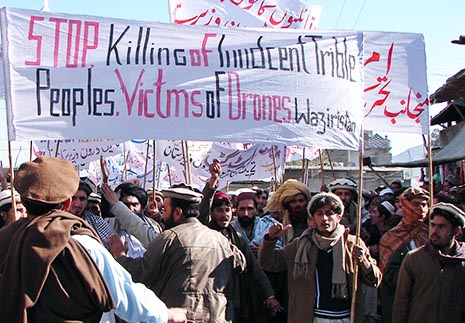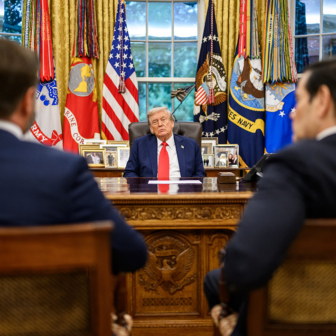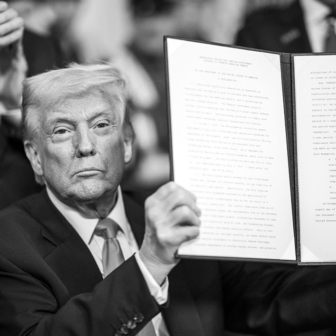IN THE spring of 2009, New York Times reporter David Rohde was being held captive by Taliban gunmen in a house in Waziristan, a mountainous region on the Pakistan side of the border with Afghanistan. Aerial drones soared overhead, filling him and his kidnappers with a sense of dread, until one day, he later wrote, “Our nightmare had come to pass.” A drone fired missiles near their house, killing several militants on a road and terrifying people in the area. He learned about the efficiency of the drones on that day and saw the wrath they incurred: “My captors expressed more hatred for President Obama than for President Bush.”
Rohde is one of the only Americans to see the drones up close: not, it turned out, as a reporter, but as a prisoner. His first-hand perspective on the strike is rare, and the novelty of his reporting underscores the difficulties of covering this new kind of war, a remote-controlled campaign officially denied by the US government, which is unfolding in a region where Pakistani officials have forbidden reporters to travel independently.
Journalists are struggling under these challenging circumstances. Even those reporting safely from afar have not succeeded in digging down to basic questions about drone attacks: How are targets chosen? Under what legal authority? How successful are drones in killing enemies and sparing civilians? Are the drones helping win the war against would-be terrorists?
War reporting is one of journalism’s highest callings, and for good reason: citizens need to know if battles are successful, and what the costs are in blood and money. But it is difficult to grasp the new war that Americans are fighting in Pakistan. As described by former US officials who participated, it is conducted not by military generals but by CIA officers in Langley, Virginia, who are guiding drones that kill people in a country with which the United States is not at war.
“I think this is an issue that we – both as a profession of journalists and the public – have accepted without sufficient debate,” says Washington Post op-ed columnist David Ignatius, who often writes about the CIA and national security issues. “There is something about assassination from ten thousand feet that is more acceptable than it would be from one foot, by the bayonet.”
Indeed, the existence of this large-scale, secretive program that is designed to “neutralise” people has become one of the biggest and least understood stories of the Obama administration. Because it is hard for journalists to bear witness, it is difficult for citizens to get a clear picture of what is being done in their name.
PRESIDENT Barack Obama has authorised around 200 drone strikes in Pakistan since he took office in 2009, more than four times the number of drone attacks that President George W. Bush authorised during his two terms, according to the New America Foundation, a Washington-based public-policy institute.
Unmanned aircraft became part of the US arsenal in the 1990s, as reconnaissance drones recorded images of terrain in the Balkans. After the September 2001 terrorist attacks, President Bush signed a directive that authorised arming the drones, called Predators, with Hellfire missiles to try to take out terrorism suspects, according to military officials. He later widened the directive to allow strikes against anyone working inside terrorist camps, not just individual suspects.
Today, according to military officials, the United States is running two drone programs: the military is in charge of drones in Afghanistan, where the country is officially at war; the CIA, meanwhile, runs the drone program in Pakistan, an ally in the war in Afghanistan. The drone operations in Afghanistan are relatively straightforward and US officials routinely release information about the attacks. In Pakistan, where the CIA is running the show, the situation is different.
Jane Mayer, the New Yorker writer who in October 2009 published one of the most penetrating stories on targeted killings by drones, says the Predators were “much more than just a breakthrough in technology – they were also a new frontier legally, politically, and morally.” In an email interview, she describes an intricate policy behind the secrecy: “It’s not, technically speaking, something that can be done under cover. But when the CIA is asked directly and on the record about its role, it denies having one.”
International politics play a role in that decision. The US government’s official denial, Mayer continues, “is in large part in deference to the Zardari administration in Pakistan, which prefers to mislead the Pakistani public about its acquiescence to the US drone strikes.” That acquiescence was always conditional and uncomfortable between the two allies, each of whom harbours suspicions about the other. In mid-April, Pakistani officials demanded that the CIA dramatically reduce its presence in Pakistan and that drone strikes cease, according to news reports, but, like so much of the US operations in Pakistan, it is unclear what is actually happening there.
In an interview published by Newsweek earlier this year, former CIA acting general counsel John A. Rizzo pulled back the curtain a little and described to me the protocol set up to authorise a drone strike. One of the approximately ten lawyers in the CIA’s counterterrorism unit would review intelligence information and draft a memo asserting that an individual posed a risk to the security of the United States. After weighing the evidence in the memo, Rizzo, who retired in December 2009, would sign his name, noting that he “concurred.” The strike was then authorised.
Despite Rizzo’s unusual candour in that interview, he and other officials have fought to keep most information about the Pakistan drone war out of the public eye. Journalists have been unable to get answers to legal questions such as on what basis the government decides to kill. This is known as “distinction” in law; in other words, how are those CIA lawyers discriminating between civilians and non-civilians who pose a grave threat to the United States? Also, how many civilian deaths can be justified? This is the question of “proportionality” in law.
At this point, so little has been written about the way the CIA chooses its targets and executes its missions that some legal scholars argue it is impossible to know whether the program is legal. “I’ve been concerned that we don’t have the right kind of permission from elected officials,” says Mary Ellen O’Connell, an law professor at the University of Notre Dame Law School. “Pakistan is not Somalia. They have a government we respect. It can be a weak government, but law doesn’t allow you to act as if there is no government.”
David Ignatius explains that Obama administration officials are sometimes willing to discuss drone operations in an attempt to promote the White House’s counterterrorism strategy. In February 2010, for instance, he was able to write a detailed account of the escalation of drone strikes because officials were eager to demonstrate that Obama was more aggressive in his pursuit of al Qaeda than Bush had been. “These rules about covert activities can be bent when it becomes politically advantageous,” Ignatius says. “When it suits them, you get quite a detailed readout.”
Yet rather than demand more consistent transparency from officials or undertake investigations that delve into the program, journalists often have simply relied on what US and Pakistani officials have told them. When reporters depend too heavily on government sources to report on a war, they end up following the narrative that White House officials have created, and in this way provide a one-sided view that obscures reality. The aerial strikes in Pakistan have been under way for nearly a decade, and yet many questions surrounding their use remain unasked and unanswered.
THE Pakistani media have covered civilian deaths from drone attacks more consistently than Western reporters have. Tallies from leading Pakistani media organisations report that as many as eighteen hundred civilians and mid- and low-level fighters have been killed in attacks since Obama took office, as compared to the twenty “high-value” militants the United States managed to kill in that period, according to New America Foundation researchers. Details about the number of civilians and low-level militants who have been killed are sketchy and have thus far proved impossible for US journalists to verify. News stories often cite anonymous Pakistani officials in their accounting of the dead.
“You’re left with this kind of shadowy world, and you pick up every discrete fact that you can – knowing all the while that you’re only getting a glimpse of something and not the whole thing,” says Yochi Dreazen, a former Wall Street Journal reporter and now a senior correspondent for National Journal.
Jonathan S. Landay, senior national security and intelligence correspondent for McClatchy Newspapers, says that when reporting in Pakistan, he has been forced to rely on the few Waziristan journalists and local officials who are reachable by cell phone for accounts of strikes. “There’s a network of tribal journalists who are very good, but one doesn’t know if you’re getting an exact count because you can’t eyeball it,” Landay says. “You can go in as an embed with the Pakistani military, but all that’s a dog-and-pony show.”
Pakistanis following news of the war get a completely different picture from people in the United States. For the past two years, there has been a drumbeat of death in the Pakistani media, with headlines like these on the website of Geo News, one of the biggest television networks in Pakistan: “US Drone Kills 22 in North Waziristan”; “US Missile Attack Kills 30”; “Death Toll in US Drone Strikes Climbs to 19.” According to former CIA officials who had operated in the region, the victims are often impoverished teenagers who have become involved with the Taliban, and are now dead. The picture that emerges through this war coverage – including in Pakistani newspapers like Dawn and the Daily Times – is one of incremental killing of bandits, drug dealers and marginal characters by airborne missiles.
When the Western media do attempt to cover drone strikes that miss any high-value targets – and which, consequently, no US official is willing to discuss – their stories are thin. An example is an Associated Press report that ran in the Washington Post on 8 July 2009: US DRONE ATTACK KILLS 12 IN NORTHWEST. Like dozens of other stories about the killings in Waziristan, the article tells readers nothing about those who were killed, why they were killed, or whether killing them had an impact on the terrorist groups that were targeted. Western reporters often learn of drone strikes from stories published in Pakistani media and, when they write their own stories, the reporters necessarily rely on local Pakistani stringers for details of the strikes beyond any scant Pakistani government information.
Pakistani citizens, not surprisingly, denounce the US drone attacks. In December, people took to the streets of Islamabad to protest against the strikes and to show support for a Waziristan resident, Karim Khan, whose son and brother were killed in a 2009 strike and who has filed a lawsuit against the United States, charging a CIA official for their deaths. In March, protests broke out in two more remote Pakistani towns. Student activists burned a US flag and an Obama effigy at one protest, saying the strikes were a violation of human rights.
THREE days after Obama was sworn in as president, his administration launched its first drone strike, according to numerous news reports. A missile reportedly hit a house in Koresh Kot, a village in South Waziristan that was believed to be a Taliban hideout.
News accounts of the incident had few, and conflicting, details, underscoring the difficulty of getting basic facts. A 23 January article on Pakistan’s Geo News website said the attack was “reported to have killed 10 people,” but did not identify them. A 23 January New York Times article reported that the missile strike killed seven, including three children, citing Pakistani news reports. The story added, “American officials in Washington said there were no immediate signs that the strikes on Friday had killed any senior al Qaeda leaders. They said the attacks had dispelled for the moment any notion that Mr Obama would rein in the Predator attacks.”
A 24 January Washington Post story cast the incident in a somewhat celebratory tone, saying it was “the first tangible sign of President Obama’s commitment to sustained military pressure on the terrorist groups.”
The news articles mentioned only briefly the most disturbing part of the story: the drone struck the wrong target. Rather than being a militant, the homeowner had been a tribal elder who had attempted to organise a peace movement and was just the kind of person that CIA operatives had been hoping to encourage in their efforts to fight extremism. The supposed Taliban hideout was actually an eight-bedroom house that had cost US$21,000 to build, a fortune in a country where the average annual income is roughly $500. The deaths of the father and others, along with the property destruction, left the family, including an eighteen-year-old son, destitute. The teenager called for revenge.
Those details were not gathered by reporters, but rather by a human-rights investigator, Chris Rogers, who was working with the Campaign for Innocent Victims in Conflict. His report, released months after the attack, shone a spotlight on the fact that civilians were killed in the assault. Rogers explained in an interview in Washington that he got the information by travelling to Peshawar, where he met with members of the homeowner’s family. Their accounts were supported by Pakistani government documents.
Journalists know that finding non-official sources is crucial in covering the drone war, especially under the tight-lipped Obama administration. “The only time I’m allowed to talk to senior staff or the NSC is for stories that make the administration look good,” Jonathan Landay says.
According to a survey of selected publications conducted by the Columbia Journalism Review, there were eighty stories about Pakistan drone strikes in major media outlets that regularly cover news in the first three months of the Obama administration, when no “high-value” Taliban or al Qaeda figures were killed but at least 115 others died. But in the three-month period starting that summer, when a drone strike killed a Taliban commander, 136 stories appeared – 68 per cent more than in the earlier period. Because reporters could only get sketchy information about the early strikes, they received little coverage. But when the commander was targeted and killed, the dire need for secrecy melted away.
At about 1 am on 5 August 2009, a missile struck a villa in South Waziristan, while a Taliban commander named Baitullah Mehsud was resting on a balcony alongside his wife. He suffered from diabetes, and a medical practitioner was administering an intravenous drip to him, “according to two Taliban fighters reached by telephone on Friday,” an 8 August New York Times article reported.
A Pakistani official quoted in the story, who had seen a video of the assault, described what happened after the missile landed: “His torso remained, while half of the body was blown up.” Mehsud was killed, along with his wife, the owner of the house, and others. Three children were also injured.
Many of the articles that appeared in the US press had a celebratory tone and reflected the mood of American officials. Mehsud was, as Washington Post reporters wrote on 8 August, “something of an obsession for the CIA.” US officials were proud of the fact that they had finally taken him out and, over the course of several weeks, spoke candidly with journalists. For example, Mehsud’s wife had been “giving her husband a massage” on the balcony before the missile hit, according to a Washington Post article on 21 March 2010.
This is selective secrecy, and it inhibits the kind of reporting that would help answer a very basic question: is the drone war working?
“Drones are here to stay,” said the New Yorker’s Jane Mayer. “So being for or against their use isn’t really where the interesting controversy is at this point. The argument is over who is a legitimate target, how that is decided, what legal framework covers this sort of warfare, and how many innocent lives can be justified as so-called ‘collateral damage’ in a drone strike – morally, legally, and politically.”
Some of the most resourceful reporters in the news business have pushed hard for more access to information about this remote-controlled battle and a few have made some progress. But too often, journalists have settled for only meagre morsels to fashion their stories. A more whole-hearted pushback is in order, with top newsrooms banding together, backed by their legal departments, to try to force a more substantive and open public policy debate on whom and how the United States decides to kill with the push of a button. •




